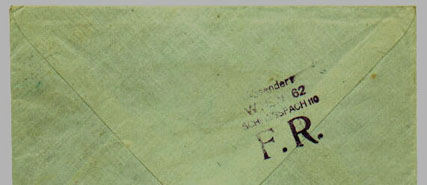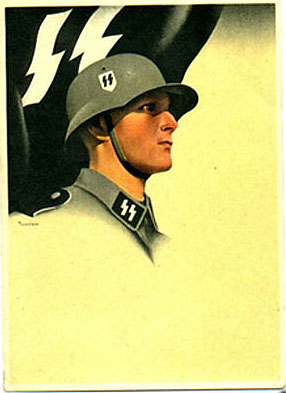Introduction
to Feldpost
|
Introduction
During
the early campaigns of 1937-39, the German Wehrmacht had a military
mailing system that provided free postal services within Germany.
By 3 September 1939, the Feldpost military mail service was placed
in motion.
Postcards and letters up to 250gms including newspapers
could be mail free of charge by the German para-military and military
organizations.
In November 1939, packages weighing up to 1000gms
were included at the nominal rate of 20Rpf fee.
All German military
branches had its own organic postal administration in charge of
receiving and delivering mail. For Feldpost offices closest to
the combat zone a mobile facility usually processed mail for all
military branches.
All military branches subordinated directly
to the "Oberkommando der Wehrmacht, (OKW)" (Supreme Command of
the Armed Forces).
By 1940, changes in the Feldpost system followed
through the rapid conquest of Europe. Eventually a series of postal
agreements were set up between Germany and the occupied countries
providing an extended usage of Feldpost service.
Countries such
as the Netherlands had close to 50,000 pro-Nazi volunteers that
during the course of the war used the Feldpost system.
Eventually
these postal agreements were settled between Germany and other
countries, including neutral countries such as: Portugal, Spain,
Switzerland, Sweden and Turkey, which had Legionnaires within
the German forces. Spain having its own formation as the 250th
Infantry Division.
To preserve the secrecy of troop movements,
each battalion was assigned a five digit code number called Feldpost
Number (FPN). By the end of 1939, letter prefixes "L" and "M"
were attached in front of each FPN to units belonging to the Luftwaffe
and Kriegsmarine. A breakdown by military units was added by attaching
letter prefixes "A" through "E" at the end of each FPN. The letter
A generally signified headquarters company, the others stood for
line companies.
The sequence of a FPN does not necessarily mean
that the location of the units were at the same area. The postal
cover/postcard itself was usually stamped with a military Feldpost
Cancellation and Official Military Unit Seal. Feldpost numbers
were sometimes reassigned to other units, particularly when a
unit ceased to exist. Normally Feldpost mail could not be dispatched
nor received by civil post offices.
If a Legionnaire wanted to
send mail through a civil post office, full postage was collected.
A "Feldpostamt, (FpA)" (Feldpost Office Number) is a tactical
number that was used mostly for mobile postal facilities closed
to a combat zone or to certain permanent facilities in the rear
areas. This FpA was devised for each Army, Corps, Division and
Independent Brigade. Each FpA was assigned a three digit code
number between 100 through 999, called Kenn. This code number
was used for routing Official Registered Feldpost mail. The Kenn
number was applied in the Feldpost Cancel and on the Register
Label. Provisions for official registered and insured mail were
offered for a small postal charge. Express mail from the front
required a 40Rpf fee. Feldpost express mail had to be delivered
by special messenger.
|
|
Legion
Feldpost
Since
most of the Legions were combat forces, mail went through the
regular "Feldpost" (field post) offices of the Herr, Luftwaffe,
Kriegsmarine and Waffen-SS. The first degree applying the usage
of Feldpost for foreigners in the German forces was 17 July 1941,
at the direction of the German Navy. Depending on the postal agreements
done with the collaborating countries, postcards, letters and
newspapers up to 250gms were delivered free of charge to all military
personnel. Packages of 250gms to 1000gms were permitted against
payment of a 20Rpf fee. To address a letter to a military member,
one had only to write the individual's name and rank and his Feldpost
unit number on the envelope. All such letters had to be submitted
for censorship.
Legion mail is categorized in the following groups:
A. Legion mail sent from the homeland to the Front Lines.
B. Legion
mail sent from the Front Lines to the homeland.
C. Legion mail
sent from soldier to soldier.
D. Legion mail using propaganda
labels (philatelic or non-philatelic).
E. Legion mail process
through civilian post office.

Flemish SS Volunteers receiving feldpost mail
SS-Feldpost
The
SS-Feldpost mail was handled separately by the designated SS-units.
The difference between ordinary Feldpost and SS-Feldpost mail
is that the cover usually bore the SS-Feldpost marking, SS unit
seal and the sender's rank (SS-Mann).
The rules requiring Feldpost
mail to bore the "SS" marking were not carried out or enforced.
The SS had mail surveillance centers, which used their own censorship
markings. In general all military mail abide the rules and regulations
governing the regular Feldpost services, however, the postal autonomy
of the Waffen-SS increased as of 1 June 1942. On 6 April 1944,
all military mail came under the SS own jurisdiction and no longer
followed the control of the OKW.
SECRET
PO BOX SS-FELDPOST
SS volunteers had secret Post Office Boxes to conceal their
association with the Waffen-SS. They were sent via air mail service
in a second envelope, address to "WIEN 62, SCHLIESSFACH 110, FR"
(Vienna, P.O. Box 110 or 113), or "BERLIN W30, SCHLIESSFACH 26,
FR" (Berlin, P.O. Box 26). Upon receipt at the P. O. Box address,
the postal clerk removed the letter from the outer envelope, stamped the
P.O. Box number on the reverse and sent via feldpost channels. The
cover was then forwarded to the addressee using probably a fictitious
German name. The letters mailed to the addressees were always censored
by the SS or army and they usually had the annotation "Zuruck an
Absenser/Neue Anschrift abwarten" (Return to sender, wait for new
address). Most of the mail originated in Romania (a few covers have the
actual sender's name/address that appeared on the inside flap). The initials
"F.R." was a commercial establishment that held Box 110.

PO BOX SS-Feldpost

[
Front Page] [Top ]
[Previous Page] [Next
Page]
|
|



